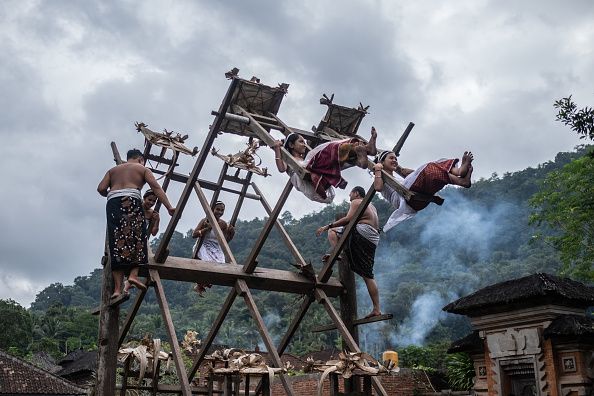Tenganan Tourism Village or familiarly called Tenganan Pegringsingan Village, is one of the ancient tourism villages on the island of Bali. Tenganan Village has the charm of hilly nature with sustainable customary forests and vast rice fields flanking the river. In addition, this village has its own uniqueness in terms of culture. Some of these uniquenesses include lifestyle patterns, double ikat Gringsing cloth weaving crafts, to the mekaré-karé tradition.
Location of Tenganan Village
Tenganan Pegringsingan Village is located at the eastern tip of the island of Bali, precisely in Manggis District, Karangasem Regency. This village is about 17 kilometers from Amlapura City Center, 5 kilometers from Candidasa Beach, and about 65 kilometers from Denpasar City.
Lifestyle
Tenganan Pegringsingan Tourism Village has characteristics as a cultural destination, especially related to pre-Majapahit Balinese culture. So this village is better known as Bali Aga Village which means old village. The life of the people in Tenganan Village is different from other villages. The village community here reflects the culture and customs of the Bali Aga village (pre-Hindu). The social system of Tenganan Village is very unique because the Tenganan Village community only consists of the local villagers, which means that there are no people from outside the village. This is because the marriage system adopted by the local community is the parental system. Where women and men in the family have the same status and have the right to become heirs.
In addition, the local community also adheres to an endogamy system. That is, the local community is bound by awig-awig (customary law) and requires marriage to be carried out with fellow residents of Tenganan Village. If a person is found to have violated it, then the resident is not allowed to become a krama (village resident). In other words, they must leave the village.
Attractions
Mekaré-karé
One of the attractions of Tenganan Village is their Perang Pandan (Pandan War) tradition, which is familiarly called mekaré-karé. Mekaré-karé is the peak of the Ngusaba Sambah ceremony held every June and lasts for 30 days. In one month, mekaré-karé takes place 2-4 times. Each time it is held, the local community will present offerings or offerings to the ancestors. Mekaré-karé is attended by men from children to the elderly.
Photo source: visitbali.id
The medium used in the mekaré-karé tradition is pandan leaves cut into pieces approximately 30 centimeters long. Its function is as a weapon to attack, or a shield to defend against attacks from opponents when dragging pandan thorns. Wounds obtained from dragging pandan thorns will be smeared with an antidote made naturally. Natural antidotes are made from herbal tubers, such as galangal, turmeric, and others.
Mekaré-karé has the same meaning as the tabuh rah ceremony often performed by Hindus in Bali. The mekaré-karé ceremony is always accompanied by the typical percussion of Tenganan Village, namely the selonding gamelan.
Double Ikat Gringsing Fabric Weaving Craft
Another uniqueness of Tenganan Village is its handicraft, namely the double ikat weaving of Gringsing cloth. The word Gringsing itself comes from the word “gering” which means sick or disaster, and “sing” which means not. So “Gringsing” can be interpreted as a repellent. The price of this craft is quite expensive because the manufacturing process is very unique and takes a long time, up to 3 years. This is what makes its existence rare and expensive.
The people of Tenganan Village are required to have Gringsing cloth as part of the means of traditional ceremonies such as ngaben. In the ngaben ceremony, Gringsing cloth is on the top of the bade (place to carry the body). In addition to bade, Gringsing cloth is also used in tooth filing ceremonies as a pillow base. It is said that human blood is used as a dye for the thread. This is because Gringsing cloth is dominated by the color red. However, the coloring materials used to make Gringsing cloth actually come from certain tree saps and candlenut seeds which are mixed in such a way that they can function as dyes.
Fun Activities
Travelers can take a tour with an ancient Balinese cultural nuance in Tenganan Village. In Tenganan Village, you can do various exciting activities while learning about the culture and customs of ancient Bali. You can see how the double ikat gringsing cloth weaving process is made and can even try wearing traditional Tenganan Village clothing. In addition, you can watch the pandan war or mekaré-karé performance which is already very famous.
To see the mekaré-karé tradition, travelers can go in June because mekaré-karé is usually held in June.
Photo source: detik.com
Facilities and Costs
The rate for traveling to Tenganan Tourism Village is subject to an entrance fee of IDR 20,000. Travelers can take a tour package around the village for IDR 250 thousand. The facilities will be taken around the village residential area while being told the concept and philosophy of the form and arrangement of traditional buildings. Travelers are also invited to witness firsthand the implementation of unique village traditional ceremonies.
In addition, they are also invited to be involved in the process of making woven crafts, writing on palm leaves and even trying on traditional clothes to be immortalized in photos. In addition, travelers will be served lunch with delicious local ingredients.
Travelers can also pay for a trekking package for IDR 250 thousand to go trekking in the village rice fields and see the traditional agricultural land processing process. Not only that, later it will also be explained about the customary rules regarding the protection of customary land, namely the prohibition of selling land to residents from outside the village. In the customary forest area, travelers will be introduced to various flora while walking along the path.
For travelers who want to have a typical village gringsing cloth woven craft, they need to spend starting from IDR 250 thousand depending on the motif and difficulty of making the cloth.



Comment (0)